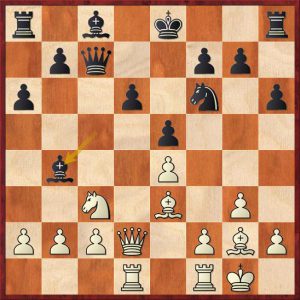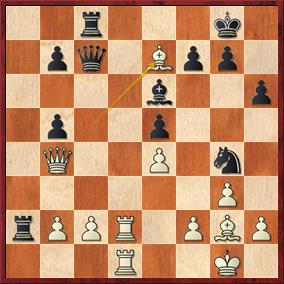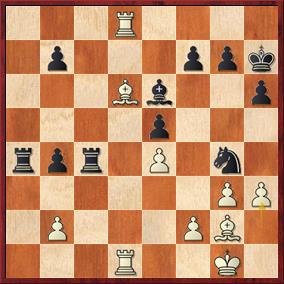Our good friend (why still?) IM Renier Castellanos annotated an interesting game from the first round of the European Club Cup for us, after spotting that a sub-2400 IM used one of Pavlidis’s novelties to hold Mickey Adams.
You can download it for ChessBase here or just read the annotations below:
Michael Adams – Rasmus Skytte
Opening preparation in practice. The first round of the European Club Cup competition brought some very interesting games but my attention was in the match between Obiettivo Risarcimiento Padova – Aarhus Skolerne. The Italian club is one of the strongest in the field and a couple of my favourite players like Adams, or my friend Paco Vallejo are playing there. In the first board Mickey Adams was facing the International Master Skytte, Rasmus (2373). A strong player I must say after I looked into his games. However it is not crazy to believe that being paired with black against a world class like Mickey Adams, chances are you are going to get squeezed and defeated badly. Before going to the game, I’d like to tell you a brief personal story that you can take as advice. When you are playing someone this strong, every wrong step will likely be punished, every inch given will be taken. That means that going sideways, playing crafty openings etc not only are unlikely to work but they are the wrong path to take in the first place. In such events the best is to rise up to the occasion and play some ”serious chess” and that means going into the main lines. I came to this conclusion a little too late after I had the chance to play Kamsky and Ivanchuk in Open tournaments. I lost both games without much resistance and I was totally unsatisfied with what I played. Basically I chose the opening randomly at the board and tried to survive on my own. In a way, I was already defeated. Now back to the game.
1.e4 c5 2.Nf3 e6 3.d4 cxd4 4.Nxd4 Nc6 Skytte is an adept to the Taimanov / Kan Sicilian family. Although he also likes to play the Pirc and Modern. So, among his options we can tell already he had chosen the most principal one.
5.Nc3 Qc7 6.g3 a6 7.Bg2 Nf6 in the past he had preferred 7…d6 8.0–0 Bd7 leading to Scheveningen schemes. While there is nothing wrong with that, it gives white too much freedom of choice.
8.0–0 Nxd4 An old line but very direct. The play now is pretty much forced.
9.Qxd4 Bc5 10.Bf4 d6 11.Qd2 h6 12.Rad1 e5 13.Be3 Bb4!? Sidestepping the main continuation which is 13. ..Be6. This line is recommended and analysed in depth in the book The Sicilian Taimanov by Antonios Pavlidis. The idea is to eliminate the knight and ease white’s pressure over the square d5. White’s next move is considered critical

14.Nb5 14.a3 is another option analysed by Pavlidis in The Sicilian Taimanov
14…axb5 15.Qxb4 Rxa2 16.Rxd6 16.Qxb5+ Bd7 17.Qb4 Ra6 is fine for black
16…0–0 17.Rd2 Be6! 18.Rfd1 A logical move which the author of the Sicilian Taimanov has also faced over the board and he analyses it well in the book. To me it is much more natural than the main line 18.f3 from the book.
18…Ng4!N The novelty given by Pavlidis. 18…Qc4 was previously played Iuldachev-Pavlidis Batumi 2018.
19.Bc5 Rc8 20.Be7

After thinking for a little less than 5 minutes, Adams is the first to deviate from the book. Pavlidis only considers 20.Bd6 Qb6 21.Bf1 with some tactical complications that are not unfavourable for black.
20…Qb6?! Black follows the book but this move now is probably not the strongest. 20…Ra4! 21.Qxb5 Rd4 is a clean equalizer. Black is taking on c2 on the next move, for example 22.Bb4 Qxc2 23.Qe2 Rxd2 24.Rxd2 Qc1+ 25.Qf1 Kh7 and black has nothing to worry about, in fact white must play accurate.
21.c3 21.Bf1 Nxf2 22.Rxf2 Rxc2 23.Rd8+ Kh7 24.Rdd2 Raxb2 25.Qxb2 Rxb2 26.Rxb2 is probably what black was looking for which is unclear. Black might hold, or he might not. Hard to say.
21…Rc4 21…Ra4! 22.Qd6 Qxd6 23.Rxd6 (23.Bxd6 Bb3 24.Rc1 Rd8 looks excellent for black) 23…b4! getting rid of the weak doubled pawn 24.c4 Rc7 25.Rd8+ (25.Bd8 Rc6=) 25…Kh7 26.Bd6 Rxc4 27.h3

And now black could try 27…Nxf2! 28.Kxf2 Rc2+ 29.Kg1 f6!! where he has enough counterplay to keep the balance. Amazing stuff!
22.Qd6 Qa7 Black seems to be wandering in a limbo, something completely understandable due to the newness of the line.
22…Rc6 23.Qd8+ Qxd8 24.Rxd8+ Kh7 25.h3 Nf6 26.Ba3 with a clear advantage for white
23.Bf1? 23.h3! Nxf2 24.Rxf2 Rxb2 25.Rdd2 Rxd2 26.Qxd2 Qa1+ 27.Kh2 Qxc3 28.Bf1! I presume this last move may be what Adams missed during the game, it is essential to win the b5 pawn soon enough. White just seems to be winning here
23…Ra1 24.Rxa1 Qxa1 25.Qd3 Rc7 The dust is off and black has a fine position. Actually, it is white who needs to be careful
26.Qd8+ Kh7 27.Ba3 Rc8 28.Qd6? 28.Qd3 Bc4 29.Rd1 with a similar position to what happened in the game.
28…Rc6? Returning the favour. Had black stopped thinking defensively and pay more attention to his position he might had seen 28…Qe1!.

This move is strong. Suddenly white has problems with Bc4 coming, or the pawn on e4, rook on d2 and f2, everything needs to be defended. Some lines: 29.Kg2 (29.Re2 Qb1 and now both Bc4 and Nxh2 are huge 30.Rd2 Nxh2 31.Rd1 Nf3+ 32.Kg2 Qxe4 33.Bd3 Ne1+ 34.Kg1 Nxd3 35.Qxd3 Qxd3 36.Rxd3 Kg6–+) 29…Rc6 30.Qd8 Bc4 31.Bxc4 bxc4 32.Qd5 Nf6 33.Rd1 Qe2 34.Qd2 Qxe4+ it’s still early, but white is lost
29.Qd3 Bc4 30.Rd1 Bxd3? Played in just 2 minutes, while is not so bad, it gives white additional chances. 30…Qxa3 31.bxa3 Bxd3 32.Rxd3 (32.Bxd3 Rxc3 33.Bxb5 Rc2 with equality, and Rc2 is not the only way.) 32…Nf6 33.f4 Rc5 looks steady for black 34.fxe5 Rxe5 35.Rf3 Kg6 not allowing Rf5.
31.Rxa1 Bxe4 32.Re1 f5 33.Be2 33.Bxb5 Rb6 34.c4 white retains some pressure, one idea is to play f3 and trade the F for the e5 pawn. With two bishops and the two vs 1 on the queenside white can put pressure for a while.
33…Nf6 34.f3 Bd5 35.Bxb5 Re6 36.Kf2 g5 Unnecessary display of activity but it also works.
36…e4 37.f4 Bc6 38.Bc4 Bd5 shouldn’t be a problem for black. The protected e-pawn is an insurance.
37.c4 Bc6 38.Bxc6 bxc6 39.Bb4 g4 40.Rd1 gxf3 41.Kxf3 Kg6 42.Rd8 Ne4 43.Rg8+ Kf7 44.Rc8 h5 45.Ke3 Kg6 46.Rc7 Nf6 47.h4 f4+ 48.Kf3 fxg3 49.Kxg3 Kf5 50.Kf3 Ng4 51.Rg7 e4+ 52.Ke2 e3 53.Rg5+ Ke4 54.Rxh5 Ne5 55.Bc5 Nxc4 A very interesting game. A great approach by the Danish player who managed to play a very decent game and even had a chance to cause a major upset! ½–½

Thanks for the game. Haven’t got into looking at this approach with much detail yet. Little bit disappointed that 7…d6 8.0–0 Bd7 couldn’t be supported because it seemed more likely to lead to a fighting game.
8.0–0 Nxd4 9.Qxd4 Bc5 seems to lead to a technical fight for draw like the old Fischer v Taimanov games. It probably doesn’t matter much at my mediocre club player level though.
Having a winning position against Adams does count as a fighting line in my book?
After 5.Nc3 Qc7 6.f4 Nxd4 7.b6 the engine`s favourite move Qf2 isn´t analysed and it indeed does look stron to me. Does anybody have an idea?
Did Renier have a falling out at Modern-Chess.com?
@Topnotch
I don’t think so. We are friends and he told me about this game and I asked him to annotate it. No bigger story here.
The reason I asked is because he never released Part 2 of his Ruy Lopez course that he began for Modern-Chess back in 2018 and an explanation was never given.
I work with him almost daily, but I do not think it is my business to ask about what his situation is with another publisher.